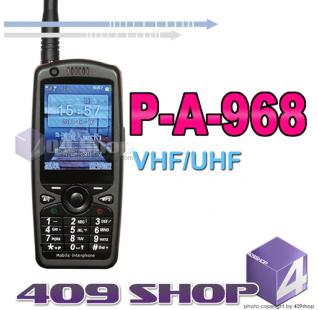
P-A-968 Cell Phone Radio Dual Band w/MP3 Player
Network:
GSM:850/900/1800/1900 MHz
UHF:400-470 MHz
VHF:136~176MHz
Size:
106.3*42*10.5 (GSM cell phone)
106.3*42*24.2 (interphone)
2-way radio cell phone: Cell Phone Walkie-Talkies P-A-968 with Transceiver U+V Dual band
•Network Frequency: 850/900/1800/1900MHz
•Screen: 2.2 inch QCIF screen: 176*220
•Feature: Cell phone, Email, FM Radio, MP3 Player...
•Camera: < 3MP
•Design: Bar
•Screen: 2 - 3"
•Model Number: P-A-968
•Operation System: mtk
•Walkie talkie frequency: U and V
•Walkie talkie moduel: built-in 2000MAH battery
•Phone battery: 750 MAH
•Frequency: 136-174 400-470 U and V
•Walkie talkie distance: 1-3km city,plain:2-4KM
•PLAYER: MP3
•128 channels, PC programming
•Input frequency by manual
•Dual sim cards, dual standby
The
cell phone walkie talkie is also known as push to talk (PTT). This
means that you need only push one button to have instant access to the
other person. The phone doesn't have to ring for the other person; he
or she will hear your voice immediately. Another benefit of the cell
phone walkie talkie is that you can talk to groups of people at one
time. You simply talk, everyone else listens, and then it is someone
else's turn to talk. If considering this use of a cell phone walkie
talkie, make sure that everyone you need to talk to has the walkie
talkie feature on his or her phone.
General Specifications:
•Frequency range:
1.UHF: 400~470MHz
2.VHF: 136~174MHZ
•Number of frequency steps: 5/6.25/10/12.5/25KHz
•Frequency stability: 2.5PPM(-20°C-60°C)
•Modulation: FM
•Speaker impedance: 8 Ω
•Antenna impedance: 50 Ω
Standard test conditions:
•Standard of supply voltage: 3.7 Vdc
•Environment temperature test: 25°C ±5°C
•Standand of audio signal: 1KHz
Receiving part
| Receiving part | Units | Typical | Limits |
|---|---|---|---|
| Receiver sensitivity (12 dB SINAD) | dBm | -122 | ≤-120 |
| Open sensitivity (SQ1) | dBm | -123 | ≤-120 |
| Close sensitivity (SQ1) | dBm | -124 | ≥-126 |
| Maximum audio output(8R single-ended load point) | V | 1.5 | ≤1.7 |
| Audio distortion(output of 1.2V) | % | 5 | ≤10 |
| Maximum signal to noise ratio(Narrowband/Broadband) | dB | 50/50 | 48/48 |
| Receiving bottom noise | mV | 30 | ≤50 |
| DCS receiver sensitivity | KHz | 0.2 | |
| CTCSS receiver sensitivity(Narrowband/Broadband) | KHz | 0.2/0.35 | |
| Adjacent channel suppression | dB | -60 | -60 |
| Receiving the maximum current(1.5Kz dev.) | mA | 350 | ≤400 |
| Standby current | mA | 70 | ≤75 |
| Low voltage directive | V | 3.4 | 3.4-3.5 |
| Emission part(test power supply voltage 4.0V) | Units | Typical | Limits | |
|---|---|---|---|---|
| RF power | UHF | W | 1.8 | ≥1.7 |
| VHF | W | 1.8 | ≥1.5 | |
| Frequency error | ±HZ | 300 | 500 | |
| Emission current | UHF | A | 1.3 | ≤1.4 |
| VHF | A | 1.3 | ≤1.4 | |
| Audio modulation sensitivity | MV | 10 | ≤20- | |
| Audio maximum deviation(Narrowband/Broadband) | KHZ | 2.3/4.7 | ≤2.5/5.0 | |
| Audio distortion | % | 2.5 | 5 | |
| Residual frequency offset(300-3KHz) | KHz | 0.05 | 0.1 | |
| CTCSS/CDCSS frequency offset (Narrowband/Broadband) | KHz | 0.5/0.7 | 0.4-0.9 | |
| Adjacent channel power(Narrowband/Broadband) | Db | -60/-60 | -60/-60 | |
| Maximum signal to noise ratio(Narrowband/Broadband) | dB | 45/42 | 42/40 | |
| Residual wave radiation | db | -65 | -60 | |
| Antenna current | mA | 1200 | 140 | |
| Charge current(5Vrechargeable battery voltage3.6-3.7) | mA | 400 | 350-400 | |